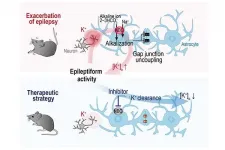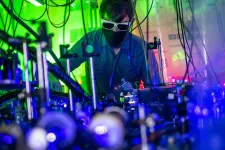New skills of Graphene: Tunable lattice vibrations
2021-03-01
(Press-News.org) Without electronics and photonics, there would be no computers, smartphones, sensors, or information and communication technologies. In the coming years, the new field of phononics may further expand these options. That field is concerned with understanding and controlling lattice vibrations (phonons) in solids. In order to realize phononic devices, however, lattice vibrations have to be controlled as precisely as commonly realized in the case of electrons or photons.
Phononic cyrstals
The key building block for such a device is a phononic crystal, an artificially fabricated structure in which properties such as stiffness, mass or mechanical stress vary periodically. Phononic devices are used as acoustic waveguides, phonon lenses, and vibration shields and may realize mechanical Qubits in the future. However, until now, these systems operated at fixed vibrational frequencies. It was not possible to change their vibrational modes in a controlled manner.
Periodic hole pattern in graphene
Now, for the first time, a team at Freie Universität Berlin and HZB has demonstrated this control. They used graphene, a form of carbon in which the carbon atoms interconnect two-dimensionally to form a flat honeycomb structure. Using a focused beam of helium ions, the team was able to cut a periodic pattern of holes in the graphene. This method is available at CoreLab CCMS (Correlative Microscopy and Spectroscopy). "We had to optimize the process a lot to cut a regular pattern of holes in the graphene surface without touching neighbouring holes," Dr. Katja Höflich, group leader at Ferdinand-Braun-Institut Berlin and guest scientist at HZB, explains.
Bandgap and tunability
Jan N. Kirchhof, first author of the study now published in Nano Letters, calculated the vibrational properties of this phononic crystal. His simulations show that in a certain frequency range no vibrational modes are allowed. Analogues to the electronic band structure in solids, this region is a mechanical band gap. This band gap can be used to localize individual modes to shield them from the environment. What's special here: "The simulation shows that we can tune the phononic system quickly and selectively, from 50 megahertz to 217 megahertz, via applied mechanical pressure, induced by a gate voltage." says Jan Kirchhof.
Future applications
"We hope that our results will push the field of phononics further. We expect to discover some fundamental physics and develop technologies that could lead to application in e.g. ultrasensitive photosensors or even quantum technologies" explains Prof. Kirill Bolotin, head of the FU working group. The first experiments on the new phononic crystals from HZB are already underway in his group.
INFORMATION:
[Attachments] See images for this press release:

ELSE PRESS RELEASES FROM THIS DATE:
2021-03-01
Tohoku University scientists and their colleagues in Germany have revealed that a first-time exposure to only a brief period of brain hyperactivity resulted in an acute breakdown of the inter-cellular network of glial cells. Pharmacological intervention of the glial plasticity may provide a new preventative strategy for fighting epilepsy.
The findings were detailed in the Journal of Neuroscience.
Epilepsy is a disorder characterized by neuronal hyper-excitation and a progression of seizures with each episode. Anti-epileptic drugs are mostly aimed at suppressing hyperactivity, ...
2021-03-01
Results of a 2018 multirocket launch at Poker Flat Research Range north of Fairbanks, Alaska, will help scientists better understand the impact of more water vapor accumulating near the fringe of the Earth's atmosphere.
"This is the first time anyone has experimentally demonstrated that cloud formation in the mesosphere is directly linked to cooling by water vapor itself," said Irfan Azeem, space physicist at Astra LLC in Louisville, Colorado, and principal investigator of the Super Soaker mission.
The NASA-funded project, named Super Soaker, ...
2021-03-01
In recent years, European forests have suffered greatly from extreme climate conditions and their impacts. More than half of Europe's forests are potentially at risk from windthrow, forest fire, insect attacks or a combination of these. This is the main result of a study by an international team of scientists with the participation of Henrik Hartmann from the Max Planck Institute for Biogeochemistry in Jena, Germany. Using satellite data and artificial intelligence, the scientists studied vulnerability to disturbances in the period between 1979 and 2018. In the light of ongoing climate change, their findings are very important for improving mitigation and adaptation strategies ...
2021-03-01
Materials called perovskites can be more readily incorporated into silicon-based semiconducting platforms by using a microfluidic pumping technology developed at KAUST.
The perovskites currently being explored for many applications in new technologies are diverse materials sharing the same crystalline structure as the natural mineral perovskite. These semiconducting materials show great promise in a variety of optoelectronic applications, such as light emitters, sensors and solar cells.
Compared to traditional semiconductors, perovskites are soft and unstable. "This makes it difficult to pattern them using standard lithography methods," says materials scientist Iman Roqan at KAUST.
The challenge tackled by Roqan and her colleagues was to adapt microfluidic technologies to manipulate ...
2021-03-01
COLUMBUS, Ohio - Parents may fear that if their high school student isn't motivated to do well in classes, there's nothing that will change that.
But a new study that followed more than 1,600 students over two years found that students' academic motivation often did change - and usually for the better.
Results showed that increasing students' sense of "belongingness" in school was one key way of increasing academic motivation.
"Our results point to a more hopeful picture for students who start out with lower levels of motivation - they tend to shift toward more adaptive ...
2021-03-01
March 1, 2021 - A new paper published online in the Annals of the American Thoracic Society discusses how smoking may affect risk for COVID-19 and the types of research that are needed to better understand the link between smoking and COVID-19 risk.
In "Smoking and COVID-19: The Real Deal," Enid Neptune, MD, and Michelle N. Eakin, PhD, of the Division of Pulmonary and Critical Care Medicine, Johns Hopkins University, discuss research to date on this topic and propose areas of research that can help clarify this relationship.
Studies have shown that current smokers with COVID-19 have twice the ...
2021-03-01
New research has determined the prevalence of private security systems may be robbing the general public of the police services they need.
Dr. Ross Hickey is an economist in UBC Okanagan's Faculty of Management and the Irving K. Barber Faculty of Arts and Social Sciences. Along with a team of researchers, Hickey examined data from a social survey of Canada victimization, where people answered whether they had added security measures to their homes to protect themselves from crime.
"We are seeing more expenditures on private security systems installed in homes and, as economists, we have to ask why. We know that crime rates are down and expenditure on police is up," says Hickey. "But private security purchases are at an all-time ...
2021-03-01
CORVALLIS, Ore. - Selectively cutting trees in riparian zones to aid forest restoration can be done without adversely affecting streams' water temperature as long as the thinning isn't too intensive, new research by Oregon State University shows.
Published in PLOS One, the study led by OSU College of Agricultural Sciences graduate student David Roon is one of the few to quantify restorative thinning's effects on forest streams.
"We don't know much about what happens with the more subtle changes in shade and light that come with thinning," Roon said. "Most of the research so far has looked at the effects of clearcutting with no stream-side buffer at all, or harvests outside of an untouched buffer area. And regulatory requirements ...
2021-03-01
Around 2.5 billion years ago, our planet experienced what was possibly the greatest change in its history: According to the geological record, molecular oxygen suddenly went from nonexistent to becoming freely available everywhere. Evidence for the "great oxygenation event" (GOE) is clearly visible, for example, in banded iron formations containing oxidized iron. The GOE, of course, is what allowed oxygen-using organisms - respirators - and ultimately ourselves, to evolve. But was it indeed a "great event" in the sense that the change was radical and sudden, or were the organisms alive at the time already using free oxygen, just at lower levels?
Prof. Dan Tawfik of the Weizmann Institute of Science's Biomolecular Sciences Department explains that the dating of the GOE ...
2021-03-01
HOUSTON - (March 1, 2021) - Rice University physicists have discovered a way to trap the world's coldest plasma in a magnetic bottle, a technological achievement that could advance research into clean energy, space weather and astrophysics.
"To understand how the solar wind interacts with the Earth, or to generate clean energy from nuclear fusion, one has to understand how plasma -- a soup of electrons and ions -- behaves in a magnetic field," said Rice Dean of Natural Sciences Tom Killian, the corresponding author of a published study about the work in Physical Review Letters.
Using laser-cooled strontium, ...
LAST 30 PRESS RELEASES:
[Press-News.org] New skills of Graphene: Tunable lattice vibrations





